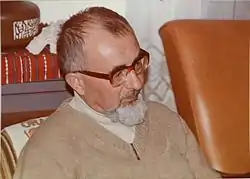Oswald Rufeisen
Shmuel Oswald Rufeisen (1922–1998), better known as Brother (or Father) Daniel, O.C.D., was a Polish-born Jew who survived the Nazi invasion of his homeland, in the course of which he converted to Christianity, becoming a Catholic and a friar of the Discalced Carmelite Order. He sought Israeli citizenship, and was refused, both under the Israeli Law of Return. However, he moved to Israel as a Carmelite friar, where he spent the rest of his life, and acquired citizenship through naturalization.

Life
Rufeisen was born to a Jewish family in pl:Zadziele[1] near the Polish town of Oświęcim, known in German as Auschwitz. During his youth, he belonged to Bnei Akiva, a religious Zionist youth movement. Hillel Zeidel, a Liberal Party Knesset member, who broke ranks and joined Menachem Begin's Likud in 1977, was a childhood friend from the movement.
In 1941, during the war, he helped to save hundreds of fellow Jews in the Belarusian town of Mir from deportation to concentration camps by infiltrating the local police station as a translator under the assumed identity as an ethnically German Pole.[2] After that he joined the partisans.[2] While in hiding in a convent of the Sisters of the Resurrection, he converted to Christianity and took the baptism from the nuns. After the war, he joined the Carmelite Order, became a Discalced Carmelite friar and eventually a Catholic priest. [3]

In the 1950s, under pressure from a wave of antisemitism by the Polish government, Rufeisen applied for Israeli citizenship under the Law of Return, which entitles Jews to immigrate to Israel. He maintained that although his religion was Catholicism he was still a Jew:
- "my ethnic origin is and always will be Jewish. I have no other nationality. If I am not a Jew, what am I? I did not accept Christianity to leave my people. I added it to my Judaism. I feel as a Jew."[4]
Different branches of Judaism treat Jews who convert to other religions differently. In Orthodox and Conservative Judaism converts are still regarded as Jews, but not in Reform Judaism. On religion-related issues, Israel follows the Orthodox interpretation of Jewish law.
The Israeli government denied Rufeisen's request, on the grounds that he had converted to Christianity. Rufeisen appealed the case to the Supreme Court of Israel, and in 1962 the Court upheld the government's decision: any Jew converting to another religion would lose their preferential access to Israeli citizenship (Rufeisen v Minister of the Interior, (1962) 16 PD 2428).
Nevertheless, Rufeisen went to the Stella Maris Carmelite Monastery in Haifa, Israel as a Carmelite friar, acquired Israeli citizenship through naturalization, and lived the rest of his life at the monastery.
In literature
The novel Daniel Stein, Interpreter by renowned Russian writer Lyudmila Ulitskaya was inspired by the life of Oswald Rufeisen.[5]
References
- Cholawski, Shalom, Oswald Rufajzen in Encyclopaedia of the Holocaust vol. 3, p. 1311.
- Tec, Nechama (2008). In the Lion's Den: The Life of Oswald Rufeisen. Oxford University Press. ISBN 978-0-19-538347-8.
Notes
- Ghetto Fighters' House Archives
- https://www.yadvashem.org/yv/en/exhibitions/communities/mir/rufeisen.asp Their Legacies Remain… We Remember Oswald], Rufeisen page on Yad Vashem website. Accessed 20 October 2020.
- Savir, Yabuda (1963). "The Definition of a Jew under Israel's Southwestern Law of Return". Law Journal (Sw L.J.). Dallas, Texas: SMU School of Law. 17 (1): 123-133 (in particular 126-129: II. The case of Father Daniel). Retrieved 20 October 2020.
- Time Magazine, Dec. 7, 1962, p. 54.
- Interview at 'MAN Booker International Prize', NDR Kultur, 26 May 2009: "The Russian author Ulitzkaja speaking about her newest book described 'Daniel Stein' as a literature character but at the same time as an historical one: <<The real Brother Daniel, whose civil name was Oswald Rufeisen, and my character Daniel Stein are not identical. The biography of my character is however almost identical to the real person. For me it was more important to follow the truthfulness of the literature narration rather than the historical truth.>>"